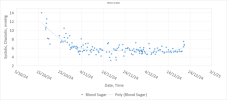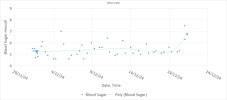Somewhat disappointed in myself this morning with my morning blood sugar
View attachment 33087
View attachment 33088
Since diagnosis in October, I've been existing mostly on a meal replacement plan, shakes and MREs I suppose, about 1000kCal. I have lost about 12kg, now at 93kg, so right direction, but it seems to have stalled. But that's not unexpected. My initial goal had been 90kg, then review.
I've been experimenting with my diet, as best I can, in the context of not having not having a CGM, only a traditional meter. For a number of weeks, my routine has been a measure first thing in the morning, and last thing at night. I had a couple of small spikes, but on the first occasion, I had a bit of a cold, which was ok, since the liver will be releasing more glucose due to the inflammatory response. And later, I had some sort of intestinal complaint (maybe effect of Metformin) which was associated with a similar non-diet related response.
I love Thai food, and my wife is Thai, and my intent is to relocate my job to Thailand in the next couple of years (I have the kind of job that can be done anywhere, and already have agreement in principle). But this won't work if Thai food ends up killing me. My wife came to the UK a few months back, and left me with a suitcase of Thai ingredients
A few weeks ago, I experimented with Pad Kha Pro Moo, a simple stir fry dish with pork, and used a little precooked frozen rice, and lots of veg. I over tested before and after, and was impressed that my blood sugars didn't shift (I'm now on 2g Metformin a day, spaced between morning and evening, at the time, 1.5g).
View attachment 33092
So I next tried Laab, which is a similar pork dish (using mint not basil), this time using a Thai/Laotian commercial mix, which was just some ground powders (difficult to know what goes into these, as the packaging is all in Thai).
View attachment 33091
Same result, all seemed well controlled. Kippers in butter, with some new potatoes also produced a similar result. A vegan curry potato pasty, also all ok. Adding extra veg to the MREs also didn't affect the numbers at the time I made measurements.
But last night I made Pad Kha Prow, but now using a Thai mix (usually, I do it myself with an Oyster sauce base, which will have some sugar, likely beet-based), with the same batch of frozen pre-cooked rice.
View attachment 33089
The Thai mix was a sauce, which I think was loaded with palm sugar. Then I had a piece of frozen whole meal bread, toasted. My night time reading wasn't the usual low 5's, but was 7.5! A retest brought it down to 6.3, which to myself, I accounted on the basis of perhaps some soap residue after washing my hands. I thought, its ok, this is still an ok value 2-3 hours after a meal. This morning though, 6.7 and 6.8, so no doubt. So very disappointed in myself, and my cockiness. Blood pressure though is rock steady though at 116/69.






